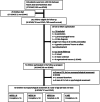Neuropsychological outcome in survivors of congenital diaphragmatic hernia at 5 years of age, what does it tell?
- PMID: 36565322
- PMCID: PMC10023636
- DOI: 10.1007/s00431-022-04696-1
Neuropsychological outcome in survivors of congenital diaphragmatic hernia at 5 years of age, what does it tell?
Abstract
Previous studies have frequently reported neurocognitive deficits in children born with congenital diaphragmatic hernia (CDH) at school age, which may contribute to academic difficulties. Yet, age at onset of these deficits is currently unknown. We evaluated neurocognitive skills with possible determinants in preschool children born with CDH. Eligible 5-year-old children born with CDH (2010-2015) who participated in our prospective structural follow-up program were included. We used the WPPSI-III to assess intelligence, subtests of the Kaufman-ABC for memory, and NEPSY-II to assess inhibition and attention. We included 63 children. Their test scores generally were within or significantly above normal range: total IQ = 103.4 (15.7) (p = 0.13); Verbal memory = 10.2 (2.8) (p = 0.61); Visuospatial memory = 11.4 (2.6) (p < 0.01); Inhibition = 10.5 (2.2), (p = 0.10). In univariable analyses, length of ICU-stay was negatively associated with IQ, and maximum vasoactive inotropic score and open repair were negatively associated with inhibition skills. In multivariable regression analysis, the latter association remained (B = 5.52, p = 0.04 (CI 0.32-10.72)). Conclusions: In these tested 5-year-old children born with CDH, neuropsychological outcome was normal on average. While problems in 8-year-olds are common, we did not detect onset of these problems at age 5. Yet, we cannot rule out that this cohort had a relatively mild level of disease severity; therefore, conclusions should be interpreted with caution. However, given the growing-into-deficit hypothesis, meaning that deviant brain development in early life is revealed once higher cognitive brain functions are demanded, follow-up should be conducted up to school age, and preferably beyond. What is Known: • Children born with CDH are at risk for academic difficulties at school age. • Whether these difficulties can be detected already before school age is unknown. What is New: • At age 5 years, intelligence, inhibition, attention, and memory skills were all within normal range, or even above, in children with CDH. This is supportive of the growing-into-deficit hypothesis in this patient population. • Those who underwent open surgical correction had poorer inhibition skills than those who were corrected with minimal access surgery.
Keywords: Congenital diaphragmatic hernia; Long-term follow-up; Neuropsychological outcome; Pediatric intensive care; Pediatric surgery.
© 2022. The Author(s).
Conflict of interest statement
The authors declare no competing interests.
Figures


References
-
- Snoek KG, Greenough A, van Rosmalen J, Capolupo I, Schaible T, Ali K, et al. Congenital diaphragmatic hernia: 10-year evaluation of survival, extracorporeal membrane oxygenation, and foetoscopic endotracheal occlusion in four high-volume centres. Neonatology. 2018;113(1):63–68. doi: 10.1159/000480451. - DOI - PubMed
-
- Global PaedSurg Research C Mortality from gastrointestinal congenital anomalies at 264 hospitals in 74 low-income, middle-income, and high-income countries: a multicentre, international, prospective cohort study. Lancet. 2021;398(10297):325–39. doi: 10.1016/S0140-6736(21)00767-4. - DOI - PMC - PubMed
MeSH terms
LinkOut - more resources
Full Text Sources

